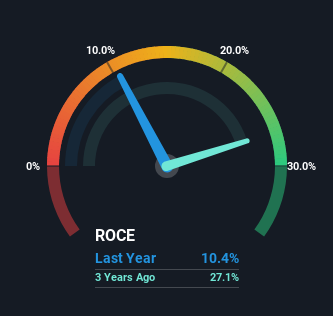- India
- /
- Food and Staples Retail
- /
- NSEI:UMAEXPORTS
Some Investors May Be Worried About Uma Exports' (NSE:UMAEXPORTS) Returns On Capital

If you're not sure where to start when looking for the next multi-bagger, there are a few key trends you should keep an eye out for. One common approach is to try and find a company with returns on capital employed (ROCE) that are increasing, in conjunction with a growing amount of capital employed. Ultimately, this demonstrates that it's a business that is reinvesting profits at increasing rates of return. Although, when we looked at Uma Exports (NSE:UMAEXPORTS), it didn't seem to tick all of these boxes.
Understanding Return On Capital Employed (ROCE)
For those who don't know, ROCE is a measure of a company's yearly pre-tax profit (its return), relative to the capital employed in the business. To calculate this metric for Uma Exports, this is the formula:
Return on Capital Employed = Earnings Before Interest and Tax (EBIT) ÷ (Total Assets - Current Liabilities)
0.10 = ₹199m ÷ (₹3.8b - ₹1.8b) (Based on the trailing twelve months to December 2023).
So, Uma Exports has an ROCE of 10%. On its own, that's a standard return, however it's much better than the 5.1% generated by the Consumer Retailing industry.
See our latest analysis for Uma Exports

While the past is not representative of the future, it can be helpful to know how a company has performed historically, which is why we have this chart above. If you're interested in investigating Uma Exports' past further, check out this free graph covering Uma Exports' past earnings, revenue and cash flow.
What Can We Tell From Uma Exports' ROCE Trend?
When we looked at the ROCE trend at Uma Exports, we didn't gain much confidence. To be more specific, ROCE has fallen from 27% over the last four years. Although, given both revenue and the amount of assets employed in the business have increased, it could suggest the company is investing in growth, and the extra capital has led to a short-term reduction in ROCE. And if the increased capital generates additional returns, the business, and thus shareholders, will benefit in the long run.
On a side note, Uma Exports has done well to pay down its current liabilities to 49% of total assets. So we could link some of this to the decrease in ROCE. What's more, this can reduce some aspects of risk to the business because now the company's suppliers or short-term creditors are funding less of its operations. Some would claim this reduces the business' efficiency at generating ROCE since it is now funding more of the operations with its own money. Either way, they're still at a pretty high level, so we'd like to see them fall further if possible.
The Bottom Line On Uma Exports' ROCE
In summary, despite lower returns in the short term, we're encouraged to see that Uma Exports is reinvesting for growth and has higher sales as a result. And the stock has done incredibly well with a 155% return over the last year, so long term investors are no doubt ecstatic with that result. So while the underlying trends could already be accounted for by investors, we still think this stock is worth looking into further.
One final note, you should learn about the 4 warning signs we've spotted with Uma Exports (including 2 which don't sit too well with us) .
While Uma Exports may not currently earn the highest returns, we've compiled a list of companies that currently earn more than 25% return on equity. Check out this free list here.
New: AI Stock Screener & Alerts
Our new AI Stock Screener scans the market every day to uncover opportunities.
• Dividend Powerhouses (3%+ Yield)
• Undervalued Small Caps with Insider Buying
• High growth Tech and AI Companies
Or build your own from over 50 metrics.
Have feedback on this article? Concerned about the content? Get in touch with us directly. Alternatively, email editorial-team (at) simplywallst.com.
This article by Simply Wall St is general in nature. We provide commentary based on historical data and analyst forecasts only using an unbiased methodology and our articles are not intended to be financial advice. It does not constitute a recommendation to buy or sell any stock, and does not take account of your objectives, or your financial situation. We aim to bring you long-term focused analysis driven by fundamental data. Note that our analysis may not factor in the latest price-sensitive company announcements or qualitative material. Simply Wall St has no position in any stocks mentioned.
About NSEI:UMAEXPORTS
Uma Exports
UMA Exports Limited engages in the trading and marketing of agricultural produce and commodities.
Solid track record with excellent balance sheet.
Similar Companies
Market Insights
Community Narratives



